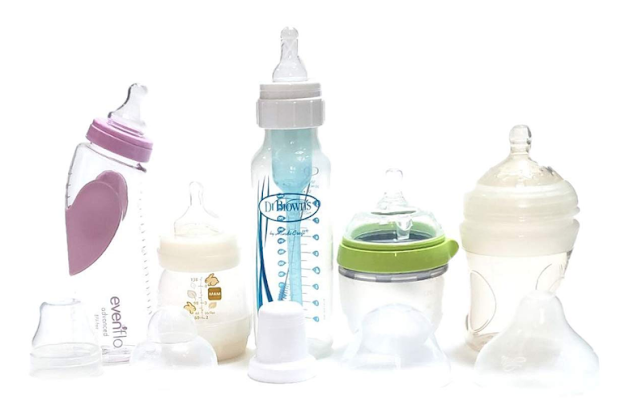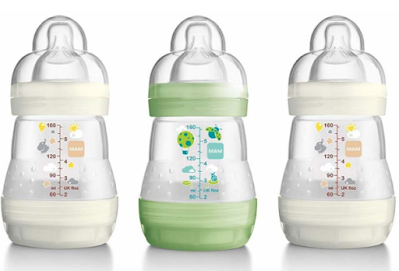- Be sure to wash your hands before handling your baby's bottles for cleaning and drying.
- Baby bottles must be cleaned with soap, not just rinsed, after every use.
- At room temperature, expressed breastmilk or formula is safe for only two hours. If you come across a bottle that's been sitting out for that long or longer, you need to toss the milk or formula that's inside and clean the bottle thoroughly.
- Feeding items should be sanitized once a day if your infant is younger than 2 months, a preemie or health-compromised. As your baby grows older, a regular cleaning after each use is enough, with occasional sanitizing for peace of mind.
- The easiest way to clean any baby bottle is in the top rack of the dishwasher. It helps to have a dishwasher basket to hold small parts, like bottle nipples. The CDC says that if you use a sanitizing cycle and heated dry cycle, you’ve effectively sanitized everything. If you wash baby bottles on a normal, quick or eco cycle and opt to air dry, you’ll want to occasionally sterilize in addition to using the dishwasher.
Hand-washing a baby bottle and its parts also works and is necessary if you don't own a dishwasher, and it's bound to happen when your dishes get backup up. The CDC suggests you put the parts in a large, clean bowl and add soap and water before scrubbing, rather than letting parts fall into the sink, in case the sink harbors germs. There are many bottle brushes you can use and any dish soap is good, though there are some brands such as Dapple Baby Bottle Soap that specifically target fatty milk residue to help remove stubborn stains.
4. How long to sterilize baby bottles in boiling water
5 minutes. Make sure all air bubbles are out of the bottles and that they are fully submerged under the water. Bring the water to the boil. Boil for 5 minutes. Let the feeding equipment cool in the saucepan before taking it out.
5. What to do with old baby bottles?
- Recycle them.
- Use them as traveling snack containers.
- Turn them into art supply containers or for rinsing out paintbrushes.
- Donate them to a local animal shelter, hospital or zoo. I think they're probably less picky about the condition.
- Give them to the kids to use with dolls.
- Use them as measuring cups for liquids.
a. It should be easy to assemble and fill
You should be able to easily put the pieces of the bottle together, which usually means popping in a nipple and screwing on the top. The bottle should also have a mouth that’s wide enough to pour milk into without dumping it onto the counter. Or, if you’re using powdered formula, the bottle should allow for easy stirring. (Pro tip: We like to use a chopstick.)
b. It should be easy to wash
When choosing a bottle, look for a shape that makes it easy to clean. Sour milk or extra formula powder can get stuck in the cracks and corners, which can lead to bad smells and make the bottle unsafe for a baby to use. Most bottles can be put in a dishwasher, but we prioritized bottles with a wider-neck shape, which made them easier to clean with a good bottle brush.
c. It needs to be leak-free
There’s nothing worse than discovering a puddle of breastmilk on the floor of the car next to a tipped-over bottle. Thus, we searched for bottles that sealed tightly and didn’t leak, even after being shaken up or dropped. Most came with lids, and we made sure that they sealed well and didn’t fall off in transit.
d. It needs to be durable
You’ll be using these bottles for at least a few months, if not for a full year, so we looked for bottles that could handle being used daily for many months without picking up nasty smells or cracking.
e. There are options for materials
Many bottles are made from a lightweight and durable plastic. However, there has been increased concern from parents over the chemicals that can be leached from plastic food or beverage containers which is why you'll see mentions of BPA or phthalate-free plastics. Some parents will opt to use glass bottles instead, and popular brands like Dr. Brown's often offer a glass version of their products. However, glass comes with its own trade-offs: it's easier to crack or break, and it's much heavier.
f. Your baby needs to like it
Most babies have varying nipple preferences, based on the shape of their mother’s breast, so this measure is a bit subjective. But based on online reviews and our personal experiences, we noticed that certain nipple shapes were easier for most babies to latch onto. Wider, shallower-shaped nipples with a skinnier teat made for an easier experience, especially if the bottle's nipple had a little bit of give, just like a mother’s breast might.
g. You might need colic-free technology
Some bottles, Dr. Brown’s in particular, are made with anti-colic vents, which limits the amount of milk your baby can take in and helps to reduce gas or air bubbles in their stomach. Other bottles, like our Best Anti-colic pick the MAM Easy-Start, use other methods to control milk flow and also allow you to 'graduate' to larger nipple sizes as your baby grows. While this isn’t necessary for older babies, pediatricians often recommend this option for infants under the age of 6 months, and especially for babies born prematurely.




















Comments
Post a Comment